Cupra Tavascan review: the electric car that aims to spice up the family SUV market

Looking for something a bit different in your life? Not too different, mind you, just something spicier; after all, you’re still probably going to buy that 4.5-metre long-family SUV.
Enter Cupra, Seat’s saucier sister, a car brand dreamed up under the watch of Luca de Meo, their former boss who subsequently moved to Renault. Cupra had been Seat’s racing division, later co-opted to develop a range of faster and better-handling versions of their road cars, culminating in the last Cupra R hatchback, which was saucier than a bishop in a bikini.
Then the badge became an independent entity within Volkswagen’s Spanish subsidiary, although there’s a fair bit of uncertainty about Seat itself. Last year, Volkswagen boss Thomas Schäfer said it would be a mobility services provider. Then Seat denied that. Then we all got phone calls asking what we understood and the public relations folk set about each other with rolling pins…
Whatever happens to Seat, Cupra is the coming thing; after a series of hybrids and plug-in hybrids, it’s headed to be an all-electric vehicle (EV) brand. A brave long game, it appears, with EV sales to private individuals falling in the UK and in Europe.
Six years on from launch, the Cupra badge is now worth €1.5 billion (although that’s a bit academic as it is wholly owned by Volkswagen) and it’s shifted more than 600,000 cars. This year it is enjoying unprecedented growth.
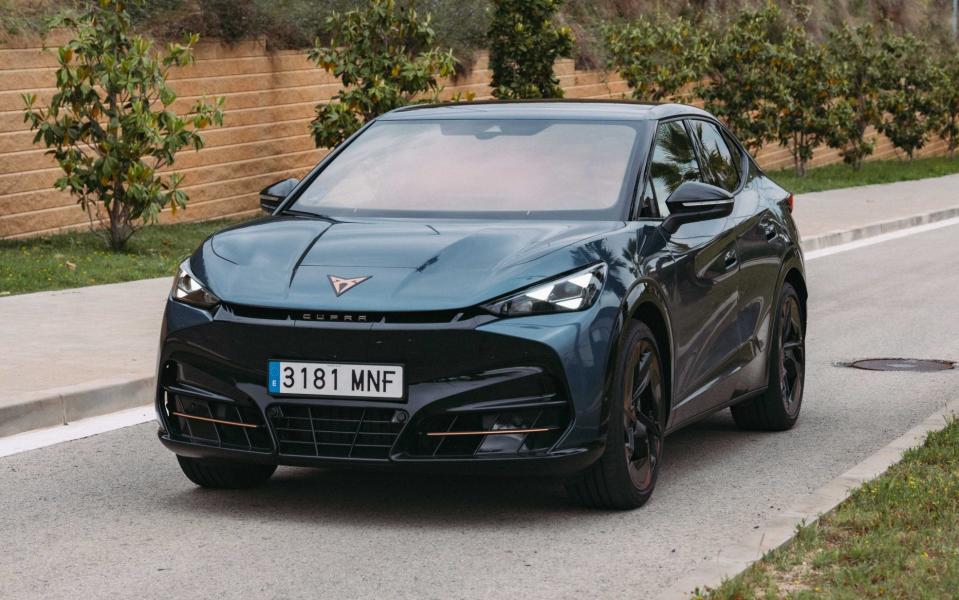
The Tavascan is part of a welter of new models arriving before the end of next year: the Terramar, a compact SUV; updates to the existing Born and Formentor models; and the Raval (formerly UrbanRebel), a 223bhp electric runabout with a range of 273 miles.
The aim is to produce up to half a million cars a year and even take the marque to North America; not bad for Seat, which was formerly Spain’s national car maker building cheap Fiats under licence.
To accompany this flurry of activity is a spangly new marketing approach modelled on Silicon Valley consumer electronic launches. Think bouncy, light-on-detail presentations to adoring crowds of influencers by shiny folk in white clothes who then walk backstage, climb in their vintage Porsches and drive to their smart Barcelona apartments. Nice work if you can get it.
You don’t just buy a Cupra it appears, you join the “Cupra Tribe”, Just for the record, US brand Dodge used this tribal marketing strategy 20 years ago – and it wasn’t much cop back then.
Tavascan explained
So are you ready to join the Tribe with a Tavascan? Billed as “the first hero of the new era” (of course it is) this 4.64-metre-long SUV follows the Born hatchback as the second EV in the Cupra range and the third unique Cupra model after the Formentor.
The Tavascan shape first appeared as a concept known as “the brand’s dream” at the 2019 Frankfurt Motor Show. The production version is built at the VW Group’s Anhui factory in China and goes on sale at the end of summer for delivery at the end of the year.
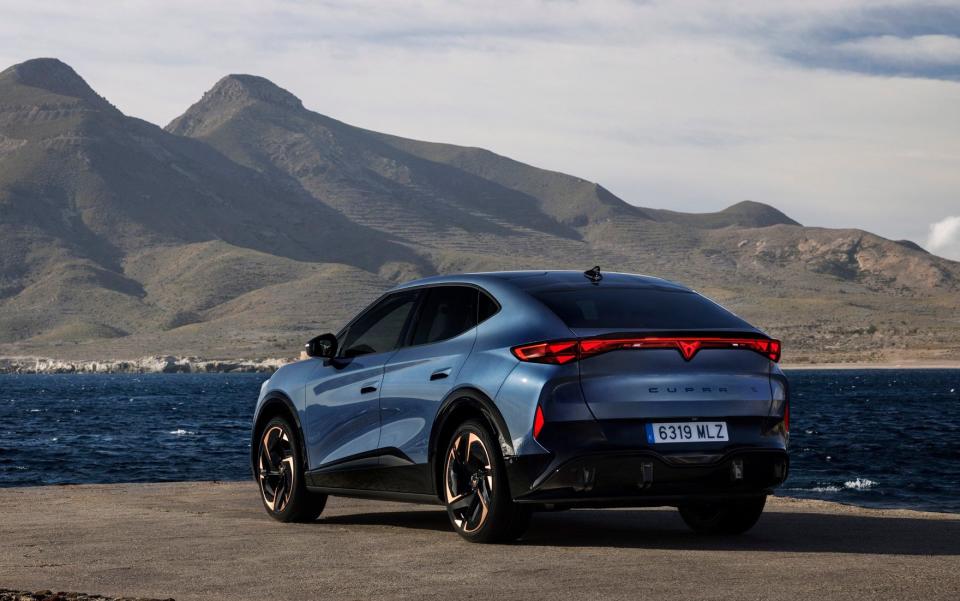
This family SUV crossover market is ubiquitous and one of the fastest growing in Europe. Even the Volkswagen Group has a lot of dogs in this race, all using its EV-specific MEB platform. They include the Audi Q4, Volkswagen ID.4 and 5 and the Skoda Enyaq. Rivals include Tesla’s Model Y, of course, along with Polestar’s 2 and forthcoming 3, Hyundai’s Ioniq 5 and Kia’s EV6.
The Tavascan measures 1,861mm wide and 1,597mm tall and runs on a 2,766mm wheelbase with a choice of 19- to 21-inch wheels.
Under the skin
The MEB-based platform comes with two drivetrains, four- and two-wheel drive and the same 82kWh gross, 77kWh useable battery. Only the 4x4 335bhp/501lb ft VZ model was available for driving at the Barcelona launch. It has a range of 324 miles, a top speed of 112mph and 0-62mph acceleration in 5.5sec. The assynchronous front motor musters just 99bhp and rear permanent-magnet unit has 281bhp.
There’s an 11kW on-board charger, the operating system is up to 400 volts and the car will support up to 135kW DC fast charging; compared with, say, Hyundai’s Ioniq 5 with its 800-volt operating system, which isn’t very fast at all. In practice, if both vehicles charge at the top of their capability to 80 per cent, you’ll be pulling away after 18 minutes in the Hyundai, half an hour in the Tavascan.
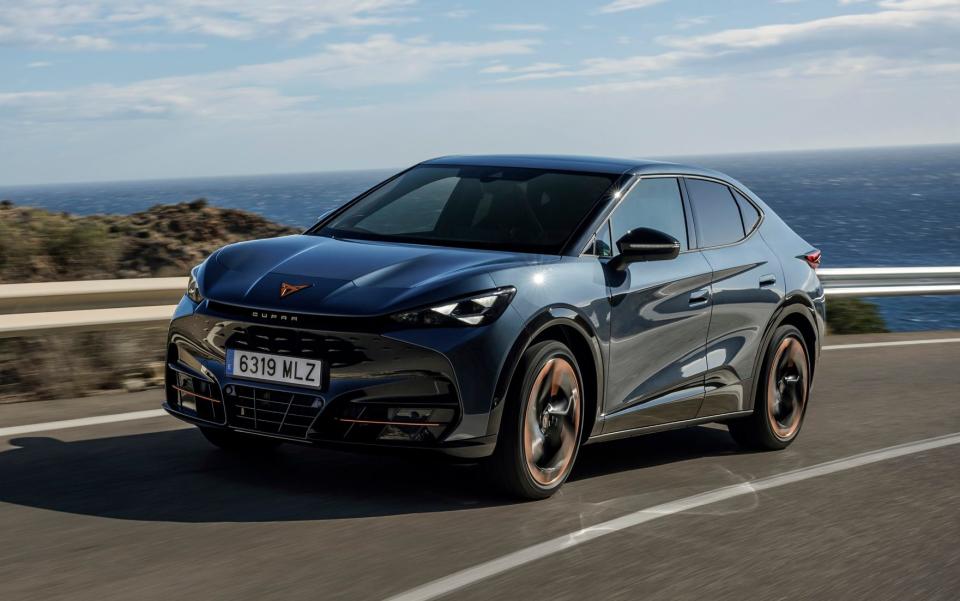
The suspension is VW Group (and class) standard fare of front MacPherson struts and a multi-link rear, tuned by Seat’s excellent chassis set-up department with sporting settings – and of course a “Cupra” button on the steering wheel which sharpens everything via the optional Dynamic Chassis Control (DCC) system.
In addition, there’s enough adaptive cruise control, intelligent lane keeping and side monitoring, driver monitoring and active battery regeneration to provide a different bleep and bloop for every metre of road you travel.
Efficiency is quoted at between 3.7 and 3.8 miles per kWh of battery energy. I achieved 3.07mkWh which gives an on-test range of 237 miles against a claimed 324. And using the latest generation figures for the UK, the Tavascan will produce CO2 equivalent at a rate of about 30g/km.
It also weighs 2.3 tonnes, which is heavy for the class.
Outside to inside
From the outside, there’s a pleasing mix of curves and aerodynamic spoilers, which ease it through the air and contribute to the coefficient of drag of 0.26. While its dark satin with copper highlights paint is distinctive on the road, the Tavascan is not such a standout piece of design as the Formentor. The sombre colours mean that on a winter’s night in Redcar, you’ll not just lose it in the car park, you’ll never know it was even there.
Step inside and there’s a lot of interior jutting at you from all directions like the horns of highland cattle. The surface changes are myriad and inexplicable. From the artfully ripped seat covers revealing Cupra logos, to soft-touch plastic on parts you are never, ever going to touch. There’s a faux and cheap-looking snakeskin theme running through the facia, which along with the copper highlights make the whole place seem like Nicolas Cage’s wardrobe. And a waveform on the dashtop, which no one asked for, ever.

In the centre is a massive (15-inch) landscape touchscreen, which contains an updated version of VW’s infuriating Cariad Golf 8 software and replaces physical buttons. They’ve made real progress with Cariad, but they needed to. The “slider” heater and volume controls are now illuminated and the touch tiles are larger and easier to use. That being said, none of it is particularly simple and you end up spending a fair bit of time with your eyes averted from the road if you are straying beyond the standard fare of heat, navigation and music.
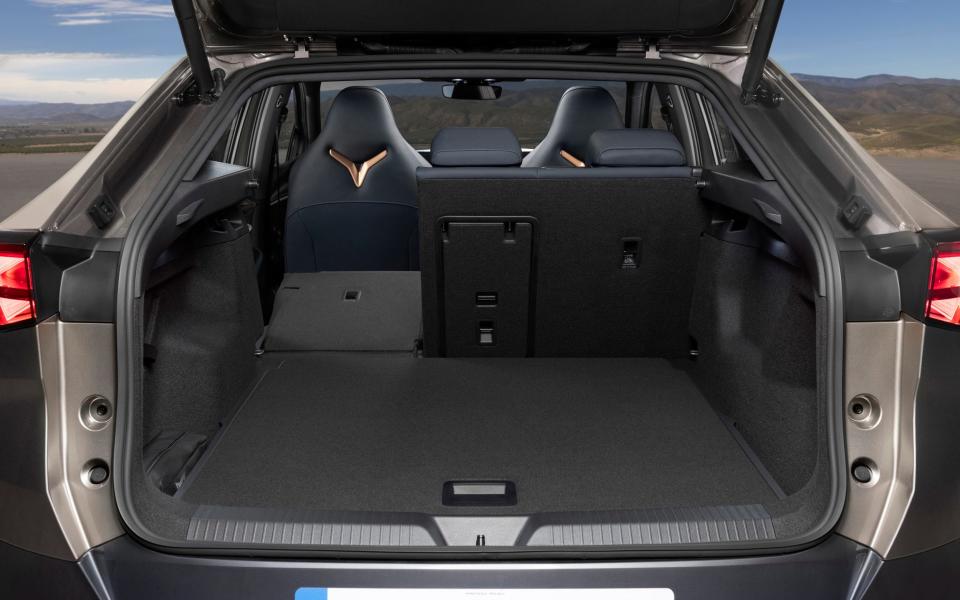
Mercifully there’s a digital instrument panel in front of the driver giving basic battery-charge information, turn-by-turn instructions for some navigation apps and speed. The bucket seats have hard backs like real racing cars but are tolerably comfortable. In the back, there’s room enough for three across, and while there’s head and leg room enough for a six-foot adult, it’s only just room enough. The boot, at 540 litres, is reasonably large, but shallow and there’s a compartment under the false floor in which to store the charging cables.
A standard heat pump and heated seats would help maintain the range during a dank English winter, although the launch cars didn’t have them. Questions about this brought a lot of mumbling replies, but we understand wiser counsel exists in the UK and the Tavascan could well come with such options as standard in Blighty.
On the road
From the off, the driving experience feels surprisingly down to earth, with decent response from the steering, progressive major controls and good ride quality despite the 22-inch wheels of the test car. There’s a bit of motor whine and some side-to-side head toss when the edges of the road aren’t perfect, but it feels honest and even a little bit sporting.
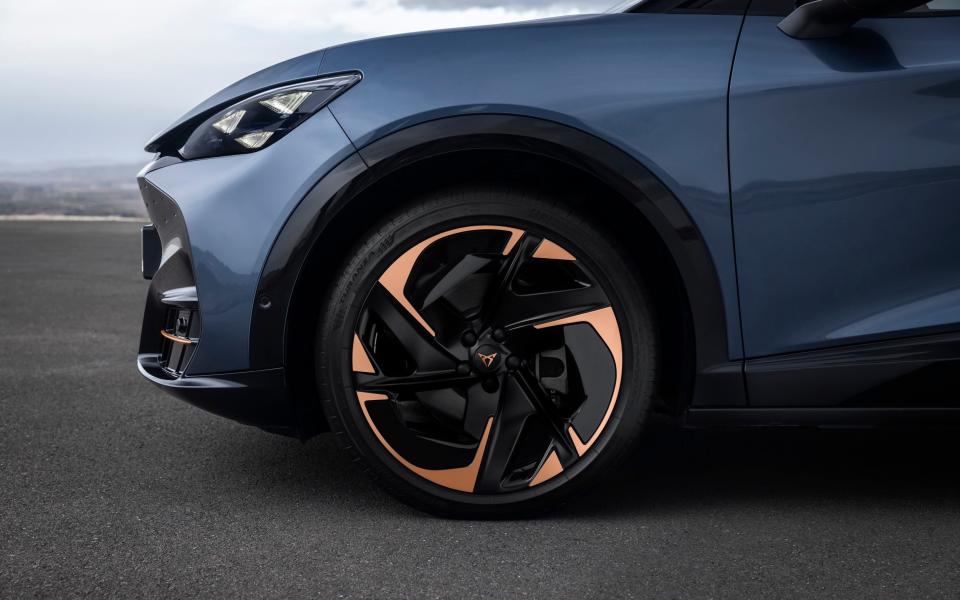
Well, it does until you use the brakes. The problem isn’t that they won’t stop the car, just that when you press the pedal you have no idea how they are going to stop the car. There’s very little grab at the top of the travel but, even worse, it sometimes builds deceleration as if you’d driven into a giant doughnut, others as if the wind direction had changed.
The brakes don’t get any better at speed, while there’s also a strange variable battery regeneration setting, which seems to switch itself on at will despite what you’ve selected via the steering wheel paddles or the B setting on the steering column-mounted gear selector.
The handling doesn’t improve, either. The 2.3-tonne kerb weight starts to tell, with a tendency to go straight on in corners and roll through turns, which affects the steering weight and accuracy. It isn’t a total disaster, but very far from the Cupra brand promise. Push hard and the tyres soon make their discomfort known soon, which also inhibits you exploiting the handling.
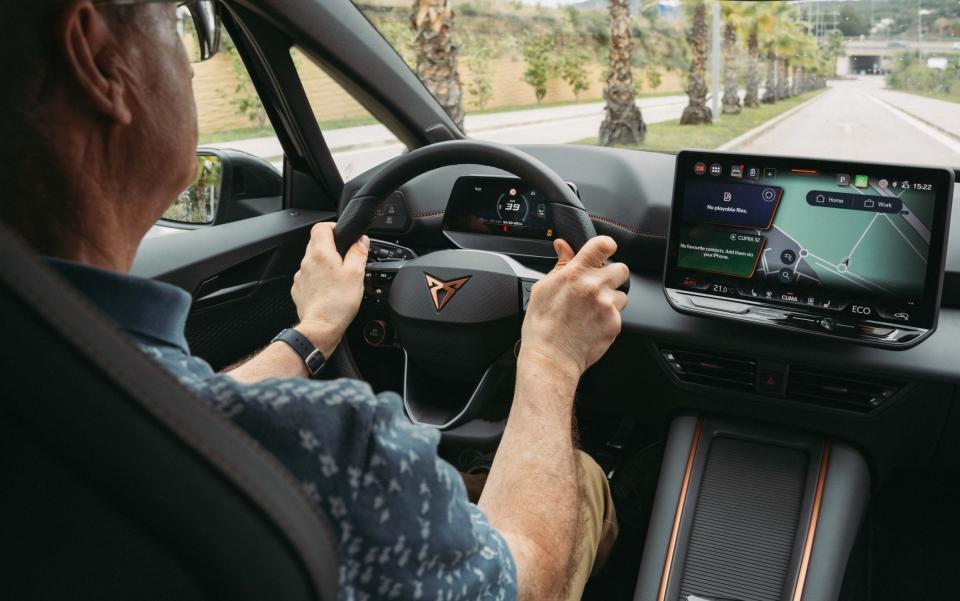
The twin motors provide a fair turn of speed, but after scintillating initial acceleration the urge tails off and it feels quite ordinary.
The Telegraph verdict
There’s lots to admire but not enough to love, which is the opposite of the great job which Cupra has done with its Born, which is based on VW’s ID.3. Cupra promises a terrific driving experience with the Tavascan and it simply isn’t. It promises sporting handling, which it hasn’t, while the brakes are horrible and inhibits your ability to exploit the chassis which promises a lot more.
If all you want is a bit of matt paint attitude, then the Tavascan is right up there, but as to whether you want to join The Tribe? On this evidence, no.
The facts
On test: Cupra Tavascan VZ dual motor
Body style: five-door premium EV family SUV/crossover
On sale: autumn 2024 for end-of-the-year delivery
How much? about £55,000 as tested (est); two-wheel-drive single motor from £47,300
How fast? 112mph, 0-62mph in 5.5sec
How economical? 3.7-3.8mpkWh (WLTP Combined), 3.07mkWh on test
Electric powertrain: twin AC motors: front asynchronous 99bhp @ 5,500rpm; rear permanent magnet 281bhp @ 3,679 lb-ft. Four-wheel drive with step down gearing for the motors. Lithium-ion NMC battery in the floor, 77kWh useable and 82kWh gross. On board charging up to 11kW, 134kW DC fast charging
Electric range: 324 miles (237 miles on test)
Maximum power/torque: 335bhp combined peak, 401lb ft
CO2 emissions: 0g/km (tailpipe), 33.2g/km (well-to-wheel)
VED: £0
Warranty: five years/90,000 miles. Battery guaranteed to at least 70 per cent of initial capacity for eight years or 100,000 miles
The rivals
Polestar 2 long-range dual-motor, from £52,950
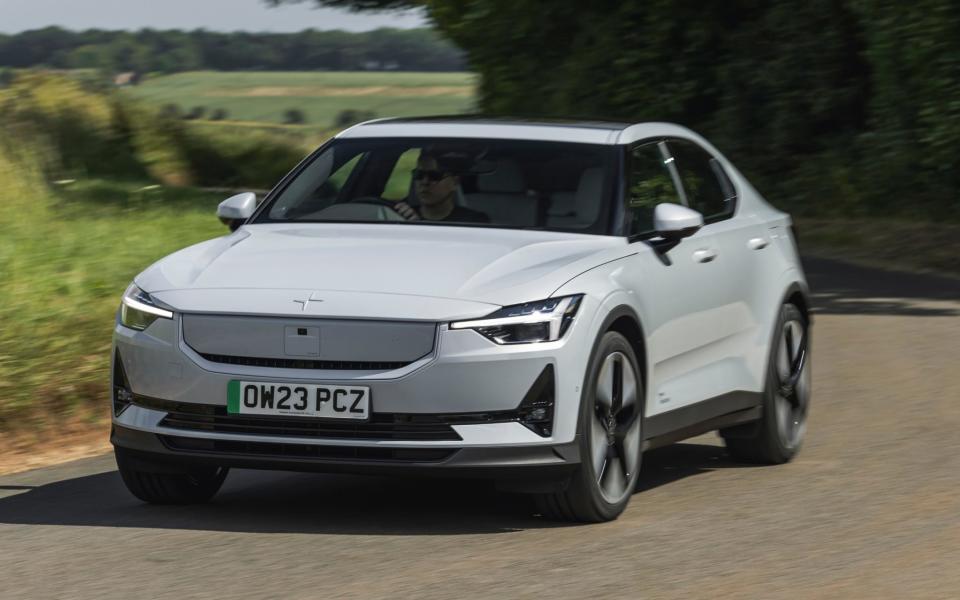
With sales and revenues tumbling, the share price is on the floor and the future for Geely’s EV brand looks distinctly shaky. New models are on the way, but for the moment this is a one-car company and though the 2 is good it sells mainly to fleets. Prices start at £44,950 but this is the most direct competitor to the Tavascan, with a 82kWh battery, twin motors, 421bhp and 546lb ft. The result is a claimed 368-mile range, a top speed of 127mph and 0-60mph in 4.3sec. The styling is unusual but it’s good to drive, fast and the interior is distinctive.
Tesla Model Y Performance, from £59,990
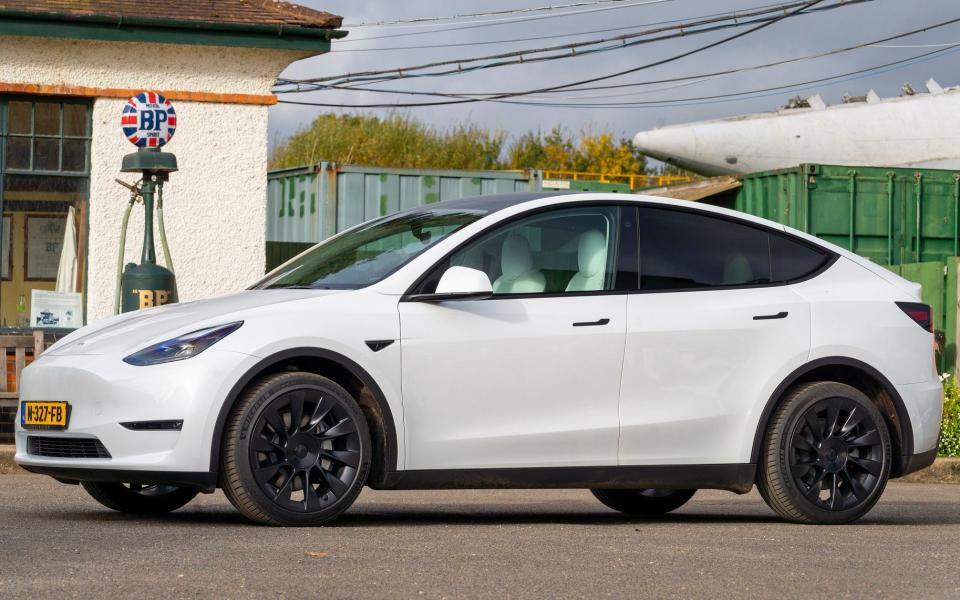
Elon Musk’s firm’s variable pricing must drive the legacy car makers – and Tesla owners – crazy. So while the Model Y is 60 grand today, what will it be tomorrow and what effect will that have on your car’s residual value? Either way, the Model Y is impressive though not that attractive. A spacious interior hides a 75kWh (useable) lithium-ion battery, with a 527bhp twin-motor 4x4 drivetrain capable of up to 319 miles, with a top speed of 155mph and a 0-62mph of 3.5sec.
Hyundai Ioniq 5 77kWh AWD, from £49,665
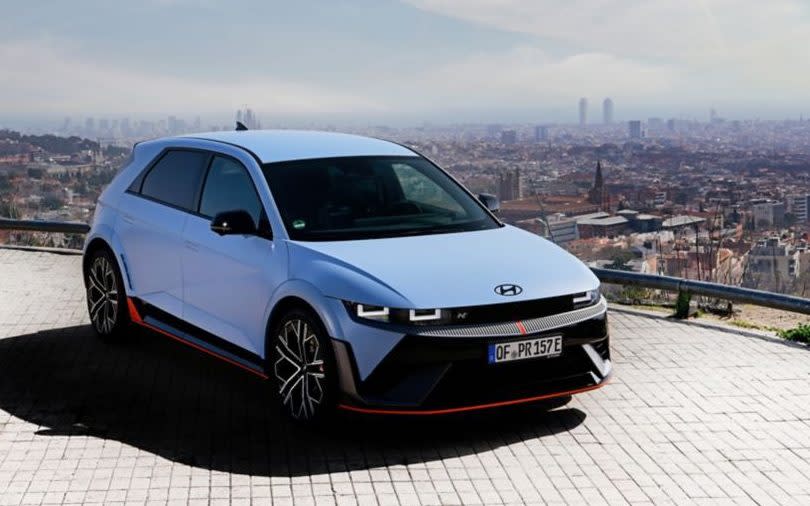
A style tour de force inside and out; early versions rode like a piano dropped out of an upper storey, although subsequent damping upgrades have improved matters. The 800-volt operating system means that regenerative braking is super efficient and DC charging is up to 240kW. The 4x4 version with the 77.4kWh battery has a top speed of 114mph and does 0-62mph in 5.1sec. It’s light, too, up to 2.1 tonnes and the range is 298 miles. While £49,665 is the entry for 4x4, prices rise to £57,165 for the fully loaded models.

 Yahoo News
Yahoo News 
